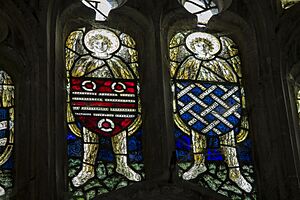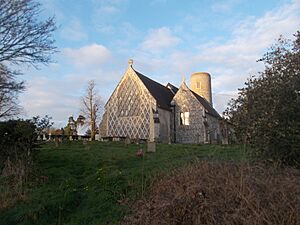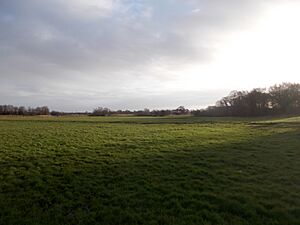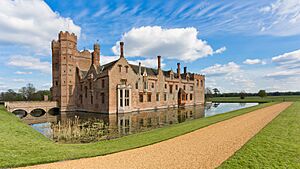Edward Echyngham facts for kids
Sir Edward Echyngham (born before 1483 – died July 8, 1527), also known as Etchingham, was an important commander on land and at sea. He was briefly in charge of Limerick Castle in Ireland and collected customs taxes in Ipswich, England. He is best known for writing a letter to Cardinal Wolsey describing the death of Lord Admiral Howard during a sea battle near Brest in 1513. Edward Echyngham came from a powerful family in Suffolk, England, and was connected to the Howard Dukes of Norfolk.
Contents
The Echyngham Family
The Echyngham family was an old and important family. Sir Thomas Echyngham (died 1444) was an ancestor who had a special monument in Etchingham church. This church was rebuilt by his grandfather, another Sir William (died 1388). The Echyngham family had a special design on their family shield, called "fretty," which looked like a criss-cross pattern.
The Echynghams of Barsham
The Echyngham family gained lands in Barsham, a village between Bungay and Beccles in Suffolk. This happened when Sir Thomas Echyngham married Margaret Knyvet around 1424. Margaret had inherited Barsham from her previous husband. Sir Thomas and Margaret had two sons and two daughters. Their younger son, Richard, inherited Barsham and other lands, starting the Echyngham family line in Suffolk.
Barsham church and its rectory (the priest's house) stand on a hill overlooking the River Waveney valley. The Echyngham family's special criss-cross pattern can be seen on the church's east wall. The family's main house, Barsham Hall, was closer to the river.
Edward Echyngham's father, John Echyngham, married Anne Wingfield. Edward had a younger brother named Francis. Anne's brothers included important figures like Sir Richard Wingfield and Sir Humphrey Wingfield. When John Echyngham's older brother died without a son in 1483, John and his children became the main male members of the Echyngham family.
Edward Echyngham was already a skilled and trusted naval captain even before his father passed away. When King Henry VIII started fighting with France, Edward was ready. In May 1512, he provided 9 soldiers for the war.
Lord Admiral Sir Edward Howard led the English navy. Edward Echyngham was one of the captains who helped keep the northern seas safe. The King prepared his navy for war and chose captains like Sir Edward Echyngham to lead the soldiers.
In August 1512, two other captains, Thomas Knyvet and John Carew, were lost with their ship, the Regent. After this, Edward Echyngham was put in charge of The Lizard ship to patrol the northern seas during winter. In February 1513, he was assigned to captain The Germyne, but later he took command of the Second new Spaniard, a larger ship with 198 men.
The Battle at Brest
In March 1513, a French fleet gathered at Brest. Lord Admiral Howard sailed to block them. Edward Echyngham joined the fleet on April 13, 1513. He chased three French warships and then safely guided supply ships to the main English fleet at Brest.
A few days later, the French attacked the English navy. On April 25, Lord Admiral Howard tried to attack the French galleys. Sadly, during the fight, he boarded a French ship but got separated from his men. He was pushed overboard and drowned.
After this disaster, the captains chose Lord Ferrers to lead them. Edward Echyngham was sent back to Southampton to bring more supply ships. He wrote a letter to Cardinal Wolsey on May 5, describing what happened and saying that strong leadership was needed to continue fighting the French.
Continuing the Fight
Edward Echyngham stayed with his ship, the Second new Spaniard. In May, he was chosen to join another mission against the French navy. He and 100 of his men were to land with Lord Lisle (Charles Brandon).
When the Scots started to cause trouble, Edward Echyngham was called to Newcastle in September. He joined the forces preparing for the Battle of Flodden Field. After the battle, he was knighted by the Earl of Surrey for his bravery. Between March and June 1514, he was the captain of a large ship called the Peter Pomegranate, which had 300 crew members.
Life at Home
Around 1515, Sir Edward's father, Sir John Echyngham, died and was buried in Barsham church. Sir Edward then inherited his family's estate. He had married Mary Bedingfield, the daughter of Sir Edmund Bedingfield, who built Oxburgh Hall in Norfolk.
Sir Edward also had a dwelling in Ipswich, a town on the coast of Suffolk. His relatives, the Wingfields, also had a main house there. In 1517, Sir Edward's uncle, Sir Richard Wingfield, suggested that Sir Edward should help transport soldiers from Norfolk, Suffolk, and Essex to Calais.
In January 1522, Sir Edward Echyngham was appointed Constable of Limerick Castle in Ireland. This meant he was in charge of the castle and had fishing rights there. His first wife, Mary, died around this time and was buried in Saint Patrick's church in Dublin. In July 1522, he took part in an English attack on the French town of Morlaix. He and his men helped capture and take goods from the town.
Second Marriage
Around 1523, Sir Edward married for a second time to Ann Everard. Ann had been married before and had children. Through this marriage, Sir Edward became related to many other important families in the area. Sir Edward and Ann had two daughters, Ann (born around 1523) and Mary (born around 1527).
Death and Legacy
Sir Edward Echyngham made his will on June 18, 1527, and died at Barsham on July 8, 1527. He asked to be buried in Barsham church. He also wanted a chapel built to Saint Katheryn on the north side of the church, where his father was buried. He asked for his mother, who was buried elsewhere, to be reburied with his father.
Sir Edward's Tomb
There is a tomb in Barsham church that is believed to be Sir Edward Echyngham's. When it was worked on in 1869, a piece of writing was found inside that said, "Here lies lord Edward..." This tomb is special because it's made of decorative terracotta panels in an Italian style. This was a popular new fashion in the 1520s and 1530s, especially among important families in East Anglia who were connected to the Echynghams.
Sir Edward left his lands to his wife Ann for her lifetime. After her, they were to go to his daughters' male heirs, or to his brother Francis, or even to his uncle Humphrey Wingfield, who he had known since childhood.
The Barsham Dole
Sir Edward also made a special request in his will for something called the "Barsham dole." He wanted this tradition to continue forever. After five special church services, every man, woman, and child who attended would go to the manor house and receive two red herrings, a white herring, a loaf of sifted flour bread, and something to drink. Those who served them would also get dinner.
Sir Edward's Daughters
Sir Edward's two young daughters, Anne and Mary, were very young when he died.
- Anne Echyngham, born around 1523. She married Sir Owen Hopton, who later became the Lieutenant of the Tower of London. Anne died in 1599. She had several children, including Arthur, William, Anne, and Mary.
- Mary Echyngham, born around 1527. There was some disagreement about who she should marry, but eventually, she married John Blennerhassett. John and Mary bought out Anne's share of Barsham and lived at Barsham Hall. They had five sons and four daughters.
|







